- Quick Read
- Deep Read ( 8 Min. )

Why is Christian Science in our name?
Our name is about honesty. The Monitor is owned by The Christian Science Church, and we’ve always been transparent about that.
The Church publishes the Monitor because it sees good journalism as vital to progress in the world. Since 1908, we’ve aimed “to injure no man, but to bless all mankind,” as our founder, Mary Baker Eddy, put it.
Here, you’ll find award-winning journalism not driven by commercial influences – a news organization that takes seriously its mission to uplift the world by seeking solutions and finding reasons for credible hope.
Explore values journalism About usIn Today’s Issue
- Distrust of police persists. This Georgia city may have a solution.
- Today’s news briefs
- Boston has had only three murders this year. What is it doing right?
- South Africans head to polls. After 30 years, has Mandela’s party lost its luster?
- The Trump trial heads to the jury – and a historic decision
- The Kremlin is all-in on war in Ukraine. That includes transforming Russia’s economy.
- To build trust with pet owners, outreach team hits the road
Monitor Daily Podcast
- Follow us:
- Apple Podcasts
- Spotify
- RSS Feed
- Download
TODAY’S INTRO
Policing and community
Communication and humanity aren’t words people typically mention first when they talk about policing in the United States.
But those concepts are very much present in our twinned stories that lead today’s Daily. Why? Because more police see them as central to effectiveness. Patrik Jonsson points to a three-city study showing a 14% drop in crime in troubled areas where police officers got training in better interactions. Meanwhile, Troy Aidan Sambajon homes in on Boston, which has just seen the biggest drop in murders of any major U.S. city. A central focus in the city is community policing.
Trust remains an issue. But thinking – and actions – are shifting.
Share this article
Link copied.

Help fund Monitor journalism for $11/ month
Already a subscriber? Login

Monitor journalism changes lives because we open that too-small box that most people think they live in. We believe news can and should expand a sense of identity and possibility beyond narrow conventional expectations.
Our work isn't possible without your support.
Distrust of police persists. This Georgia city may have a solution.
Respect between citizens and police is critical to society. One police department is showing how better relationships ward off trouble. Since it began rebuilding trust, crime has been cut in half.
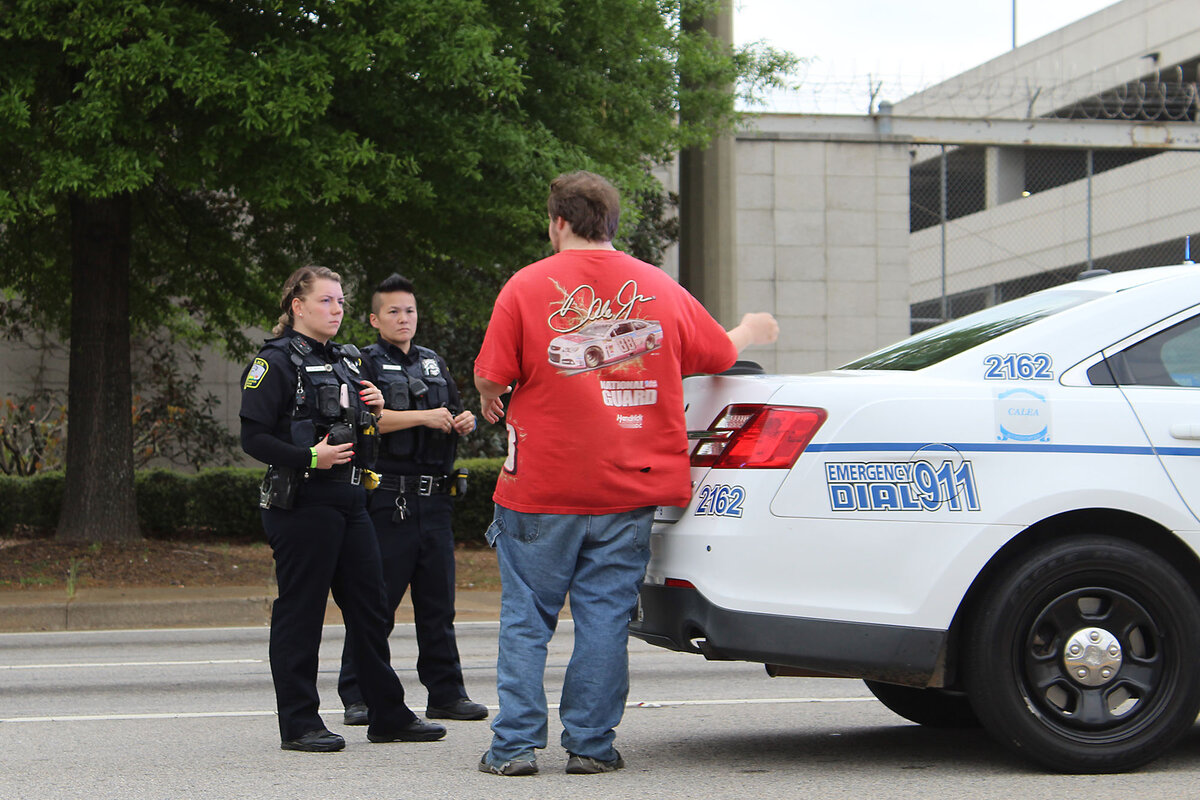
Despite falling U.S. crime rates, public trust in police hasn’t improved in recent years. If anything it has declined a bit since 2020, according to polling by Gallup.
Police departments across the United States are trying not only to build trust, but also to reestablish expectations of police – and show how more equitable policing prevents crime and protects officers, too.
“We’re stronger and better together” is the slogan of a local sheriff candidate here in central Georgia.
Over a dozen Georgia jurisdictions are now taking “a social worker approach” to help those entangled with law enforcement but who struggle with mental health as well.
In one study of policing spanning three cities in Texas, Arizona, and Massachusetts, researchers saw crime drop by 14% in high-crime areas where officers were trained to be more respectful and communicative.
In Georgia, the LaGrange Police Department has also shown that better policing is possible and can drive down crime, which has fallen by half.
“There is good evidence that when interactions with police improve, crime goes down,” says Neil Gross, a sociologist at Colby College.
Distrust of police persists. This Georgia city may have a solution.
It could have all ended very badly.
After a LaGrange resident’s car was repossessed, the man’s entire family – his son, his son’s fiancée, and their baby – engaged in a high-speed chase through downtown LaGrange, with the family using another car to chase the person who repossessed their car, weaving through traffic at high speed.
When police finally stopped the cars, emotions ran high. Their faces deep in concern, the LaGrange Police Department officers talked calmly with all involved until passions subsided.
“It’s important to remember that everyone involved is human – and humans get emotional,” said Officer Braxton Willis as the scene cleared. “Part of our job is managing those emotions.”
Ultimately, peace prevailed. The police arrested the driver for reckless driving, gave the son a ticket for disorderly conduct, and put the fiancée, who was having breathing problems, in an ambulance. The baby looked on calmly from the arms of his grandmother, who arrived at the scene after the traffic stop.
Three years ago, Officer Willis entered a profession in deep flux as police departments across the United States confronted not just local crime waves but a national uproar on equity and civic rights. Now, Officer Willis’ department in this town of 30,000 people about an hour’s drive outside Atlanta is at the front of that debate – experimenting with how new policies aimed at addressing race and class disparities can dovetail to produce a more effective force.
At heart of these nationwide efforts are questions around whether policing can live up to its “serve and protect” ideals. That takes not just updating rules, but also moving police culture toward more democratic values.
“I’ve started to see some movement on that front,” says sociologist Neil Gross, a former Berkeley, California, police officer who now teaches at Colby College in Waterville, Maine. “Police have taken that movement seriously beyond slogans.”
A tale of three cities
In a three-city study of policing in Houston; Tucson, Arizona; and Cambridge, Massachusetts, researchers saw crime drop by 14% in high-crime areas where officers were trained to be more respectful and communicative, according to a report published in Proceedings of the National Academy of Sciences. Another study of door-to-door visits by police officers in New Haven, Connecticut, resulted in greater support by citizens for boosting department funding.
If there’s progress, that doesn’t mean experts on criminal justice are entirely happy with trends in U.S. policing. Some departments continue to violate civil rights. The recent sentencing of a “goon squad” of white officers that tortured Black citizens of Mississippi’s rural Rankin County is proof of that.
Even in places without such horrific behavior, watchdogs say things like racial profiling and excessive force by police remain common.
“The question ... becomes: What is the definition of ‘respect’?” Michael Collins, senior director of state and local government affairs at the social justice organization Color of Change, says in an email response to questions from the Monitor. U.S. police, he notes, continue to perpetrate violence at world-leading rates, particularly against communities of color. “That is not respect, and anyone in contact with [police] knows it.”
Despite falling U.S. crime rates, public trust in police hasn’t improved in recent years, according to national polling by Gallup. If anything it has declined a bit since the protests following the 2020 murder of George Floyd by a police officer in Minnesota.
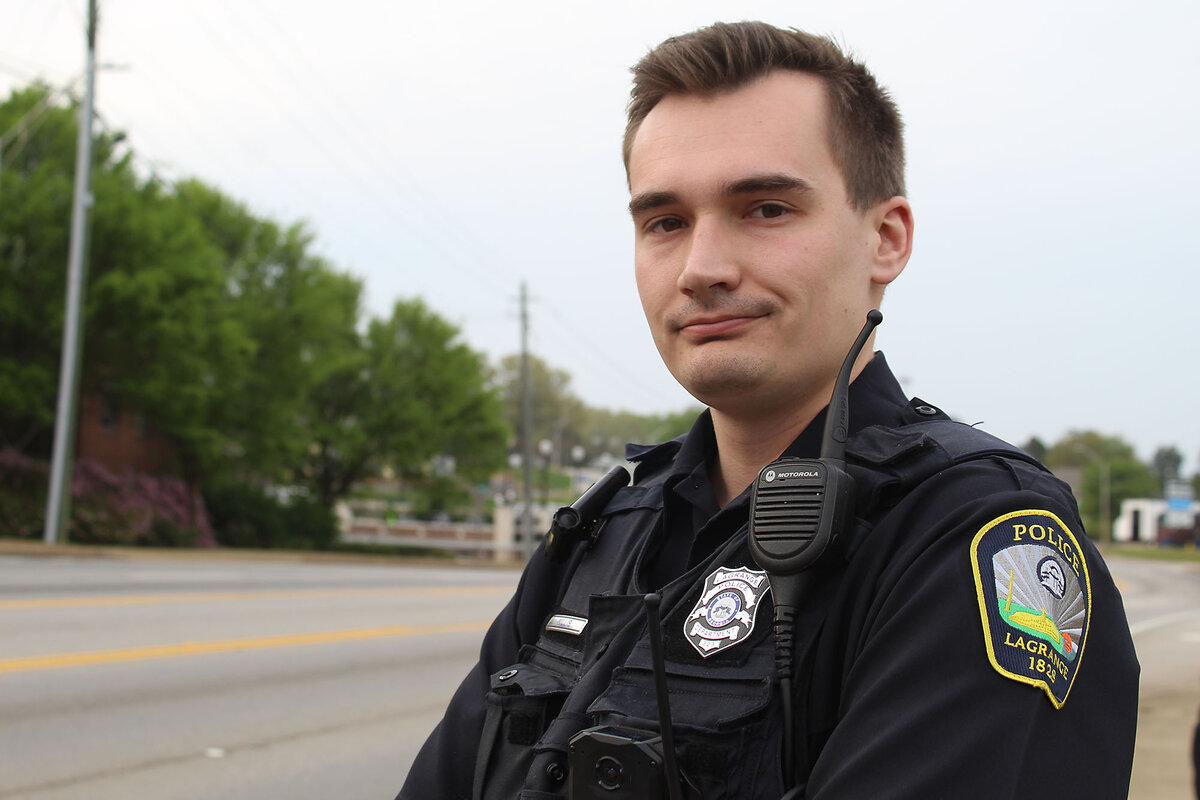
Political leaders have squabbled over whether police should be less aggressive or, as former president Donald Trump has suggested, “not be so nice” to suspects.
Yet “nice” appears to have some momentum.
The power of nice in LaGrange
LaGrange Police Chief Louis Dekmar, now recently retired, went on a mission to build trust through good will. He is hardly alone.
From California to Tennessee, a policing movement that focuses more on problem-solving and affirming the value of police presence is part of a deeper realization by law enforcement that “if we don’t change, others will do it for us,” as former Chief Dekmar says in an interview.
LaGrange residents agree. “We want police,” says LaGrange resident Isaiah Wright. But “we just don’t want police who always treat us as suspects of a crime.”
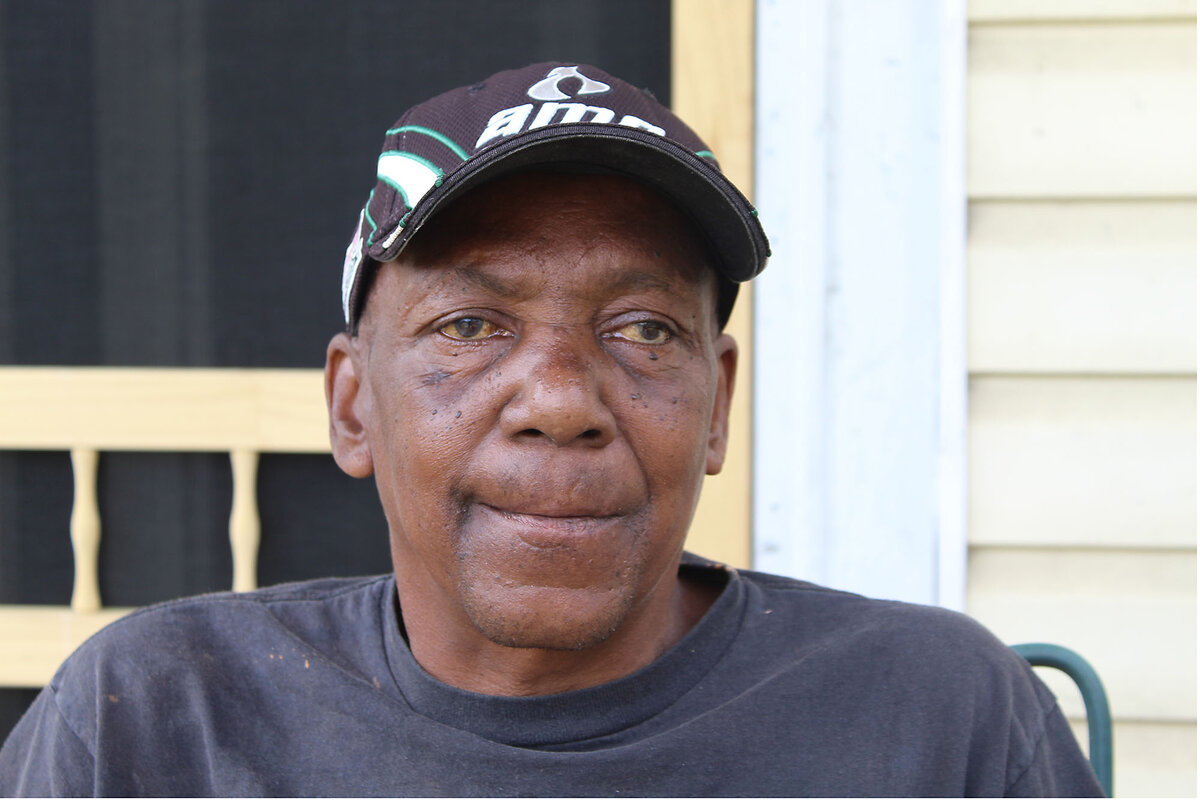
At the core of the effort is not just building trust, but also reestablishing expectations of police – and how more equitable policing can, in fact, work better for fighting and solving crime, while protecting officers as well.
The “kinder is better” mantra isn’t just in police departments. “We’re stronger and better together” is the campaign slogan of a local sheriff candidate here in central Georgia.
Over a dozen Georgia jurisdictions now have units taking what they describe as “a social worker approach’’ to better work with those entangled with law enforcement but who struggle with mental health as well.
Savannah, Georgia, now has more female officers per capita than New Zealand, the nation with the highest percentage of female cops. This old, coastal American city emphasizes how some female officers tend to take a softer approach.
“Bad cop turns good cop” approach
Other cities and counties across the U.S. are also trying this time-tested “bad cop turns good cop” approach. Stockton, California; Longmont, Colorado; and New Orleans are all standout cities working to create friendlier police cultures, some experts say, by asking officers to treat others the way they want to be treated. The value of hiring more skilled police officers also seems to be gaining ground. Last year, Alameda, California, began offering $75,000 hiring bonuses to new recruits.
“Kindness and understanding – the same types of traits you want in a best friend – also work in the domain of law enforcement,” says psychologist Christian Hart, a professor at Texas Woman’s University in Denton.
What the LaGrange Police Department has shown is not just that better policing is possible, but also how it can be done in a way that drives down crime.
Some moves are simple. The police department inserted the word “compassion” into its credo. Other policies are aimed at eliminating disparities of class and race when it comes to criminal justice outcomes.
Some examples:
- LaGrange allows officers the option of shoot-to-incapacitate an armed attacker instead of aiming for more lethal center mass, the U.S. standard. The policy has saved one life so far.
- The department has worked with auto parts stores to develop a coupon program that serves as a proactive, “solve the problem” warning for tail light violations. Hundreds of coupons have been given out, alleviating pressure on the courts and building goodwill.
- The department instituted a confidential “handle with care” bulletin that goes out to the local school system when a student has been involved in a police situation, so as not to revictimize innocent people in case they struggle at school as a result. Chief Dekmar says regular such bulletins go out, shielding minors from being victimized.
Talking it out
Wyoming-born and a “Southerner by choice,” Mr. Dekmar was well into his 30-year career before experiencing a professional epiphany. Even before the killing of 18-year-old Michael Brown by police in Ferguson, Missouri, and the national concerns arising out of that 2014 event, Mr. Dekmar was in dialogue with a local outreach committee about police practices.
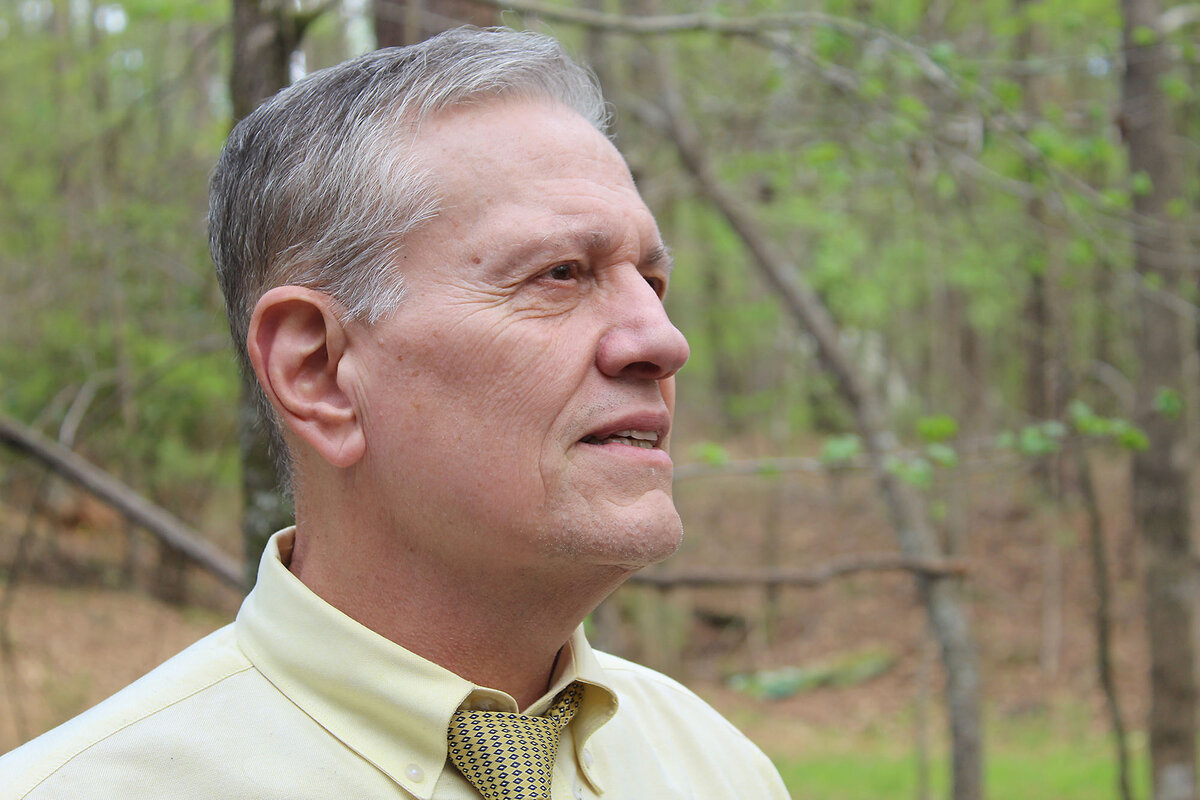
In 2017, in an unusual but effective move, Mr. Dekmar apologized to his community, on behalf of local law enforcement, for the 1940 death of Austin Callaway, a young Black man taken from jail and lynched by six white men, a crime abetted by the LaGrange Police. Community heads turned.
“Until that point, I didn’t understand how history intertwined with the present in a powerful way,” says Mr. Dekmar. “It is incumbent upon police to step forward and start engaging in a way that develops trust.”
David Mixon could be Exhibit A.
During a long prison stint for robbery and kidnapping, Mr. Mixon had been called, per policy, by his last name. But when he transferred to the LaGrange Police Department, everybody began calling him David. At first, it made him uncomfortable. Growing up in Atlanta, he had in the ’80s watched police officers brutalize residents.
Fresh starts, new approaches
But the humanity that he felt when the LaGrange officers used his given name became a “new name” moment. A fresh start. It “changed my whole outlook on law enforcement as a whole,” he says.
Now a free man, Mr. Mixon wears police gear as an Animal Control officer. Responding to calls, he offers the same courtesy – listening to animal owners, educating them, and, as a last resort, writing them a ticket or seizing mistreated animals. It’s not easy, he admits. “It can get crazy out there.”
In the past few years, departments across the country that lean into compassion are seeing results.
In LaGrange, during Chief Dekmar’s tenure, overall crime fell by half. The city’s murder-solve rate – often a gauge of police-community cooperation – has gone from 79% in 2012 to 84% last year. The historic average for surrounding Troup County, which has half as many homicides, was 55% between 1965 and 2022. For nearby Bibb County, it was 68% over that same period.
Critics have blasted such approaches as soft on crime and “woke,” and voters in many jurisdictions still demand tougher measures.
“Broken windows” policing in the 1990s showed that crime can indeed be deterred by aggressive posture on the street. But it shattered trust in many neighborhoods.
“There is good evidence that when interactions with police improve, crime goes down,” says Professor Gross at Colby.
Why that’s true is not yet fully understood. But it suggests that the issue is not police authority itself but the way authority is exercised. For much of the modern era, police authority in America has been tied to the badge and the gun. But when authority is granted by the community, it can have a noticeable impact.
That is “legitimate authority ... where everyone recognizes their authority and wants them to have that,” says Professor Hart, the director of the Human Deception Laboratory at Texas Woman’s University.
Back at the road rage incident in LaGrange, the baby’s grandmother said she didn’t agree with the charges. But she noted that the local officers had managed a fluid situation well.
“They’re trying to be better than they were,” she says.

Today’s news briefs
• Israeli strikes in Rafah: Renewed Israeli shelling and strikes have killed at least 37 people, most of them sheltering in tents, outside the southern Gaza city of Rafah. The bombardment hit the same area where Israeli strikes triggered a deadly fire in a camp for displaced Palestinians days earlier, killing 45 people.
• Haiti’s new leader: Haiti’s transition council taps former Prime Minister Garry Conille, who briefly led the country over a decade ago, to return to the role as the Caribbean nation works to restore stability and take back control from violent gangs.
• Russian hacking rises: Disruptive digital attacks, many of which have been traced to Russia-backed groups, have doubled in the European Union in recent months, according to the EU’s top cybersecurity official.
• Israel captures key corridor: Israel’s military says it has seized control of the entire length of Gaza’s border with Egypt.

Boston has had only three murders this year. What is it doing right?
Boston has been a pioneer of community policing. That’s showing signs of success. The next step is to build a deeper sense of trust with residents.

- Quick Read
- Deep Read ( 5 Min. )
Monalisa Smith can’t say she completely trusts the Boston Police Department. “Those memories of police brutality, that’s passed down from generation to generation,” says the president and founder of Mothers for Justice & Equality. “Those realities are still there for our young people, especially our young men.”
Yet something is changing, she says. “In some ways, it feels like we can finally have a seat at the table.”
Boston has long been a leader in policing tactics that seek to build relationships within communities. Now, it seems, they are paying off. The city is seeing historically low levels of violence, with only three murders so far this year. But Ms. Smith and others talk about the BPD’s increasing openness and creativity. The next step is to turn wary cooperation into genuine trust.
“It really comes down to dialogue. That’s the key,” says Jack McDevitt, a criminologist at Northeastern University. “They need the community as a partner.”
“We learned in Boston a long time ago that the police can’t solve the problem of violence by themselves,” he adds.
Boston has had only three murders this year. What is it doing right?

Some of the crime statistics coming out of Boston lately have been almost hard to believe.
Last year saw a historic low in shootings, with only 37 people killed – compared with 200 or more in similar-size cities such as Detroit; Memphis, Tennessee; and Washington. Remarkably, this year is even better. Homicides are down 82%, according to the Boston Police Department – the biggest drop of any major city in the United States. Shooting incidents are down 44%.
As of May, only three people have been murdered in Boston this year.
Yet only 31% of Bostonians believe the police treat everyone equally regardless of race, according to a 2021 WBUR poll. Among Black respondents, that number was 17%.
Boston is at once a prime example of what is going right in policing and of how much remains to be done. The city has been a pioneer since the 1990s in policing strategies that embrace communities as partners and collaborators. Those are now paying off, Boston Police Commissioner Michael Cox has said.
Yet past missteps are hard to erase, and trust is only built through sustained success, achieved together. It doesn’t come overnight, but with commitment over time. Now, there are signs that trust is finding a new foothold. While watchdog groups say much work lies ahead, they acknowledge an openness to more voices and new thinking at the Boston Police Department, which offers the hope of more progress to come.
“Those memories of police brutality, that’s passed down from generation to generation,” says Monalisa Smith, president and founder of Mothers for Justice & Equality. “Those realities are still there for our young people, especially our young men.”
That means the “unflinching trust in the police might not be there,” she says. “But in some ways, it feels like we can finally have a seat at the table.”
When things began to change
Crime in Boston has been trending downward for years since its peak in the 1980s and ’90s. Longtime residents point to the Charles Stuart case in 1989 as the low point in trust between the community and the police force. Mr. Stuart murdered his wife and pinned the blame on a fictitious Black gunman, leading to two mistaken arrests. The explosion in crime afterward led to Boston’s investment in youth and programs connected to community needs.
Today’s drop in crime likely has many factors, including a higher-than-average homicide solve rate and an increase in anonymous tips. But these also point to the importance of the community ties built up in recent decades.
“We’ve been practicing community policing for a long time,” Mr. Cox told The Boston Globe. “I think we’re receiving the benefit of actually establishing a true partnership with the public like we had before, and this is the fruits of that relationship.”
Mr. Cox declined a Monitor interview request. The BPD communications department did not respond to multiple requests, in person and by phone and email, for a statement.
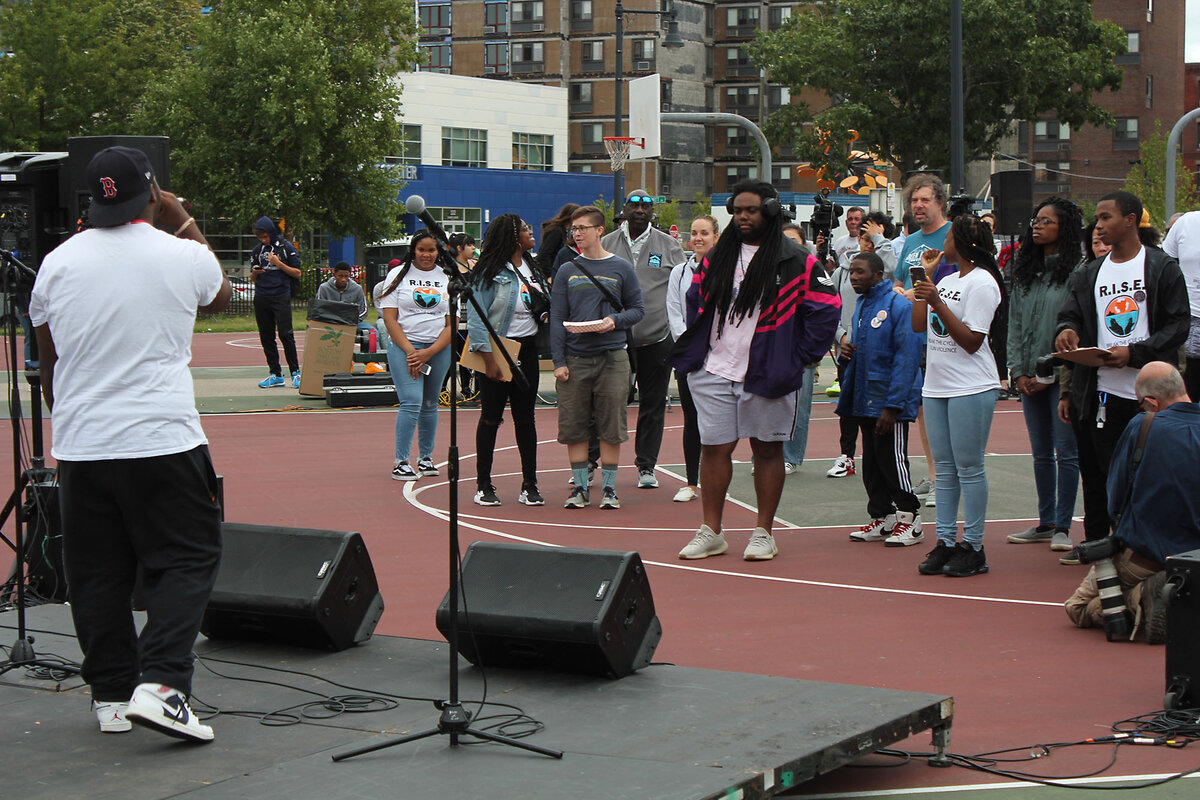
Former Boston Police Commissioner Bill Bratton, who was famous – and infamous – for his “broken windows” strategy, once described community policing as getting out of the patrol car and walking the community streets, getting to know people’s names. Most importantly, it’s about forging partnerships with residents.
“It really comes down to dialogue. That’s the key,” says Jack McDevitt, a criminologist at Northeastern University in Boston. “You want to include the community in the decisions about how they are policed. You can give them feedback and really include them as an actual partner in your strategies.
“We learned in Boston a long time ago that the police can’t solve the problem of violence by themselves. They need the community as a partner.”
Boston’s biggest success
Ms. Smith of Mothers for Justice & Equality sees signs of progress in these areas.
The city has made great strides “around preventing and getting our youth off the streets,” she says. “It’s the community-based models that are doing better with educating our children. There are many more resources being put there.”
The greatest success has been YouthConnect, a partnership between BPD and the Boys & Girls Clubs of Boston. The program places licensed social workers in police stations to address the underlying causes of juvenile delinquency and, hopefully, prevent crime before it starts.
YouthConnect’s approach is unique, compared with other social work models integrated within police departments. The duty of the YouthConnect social worker is to address the needs of the entire family, not just of the youth at risk.
Last year, YouthConnect made more than 2,500 referrals to other service providers. Those could be anything from connecting a family member to a job opportunity to helping struggling students engage with summer camp or after-school learning programs.
Nearly 85% of youth say yes to services when YouthConnect makes its calls to families, and the numbers of both YouthConnect referrals and “yes” responses have increased over time, showing mounting trust and effectiveness.
“Our social workers are working out of the clubs and building trusting relationships because people see them as who they are, and not just as social workers,” says Robert Lewis, president of the Boys & Girls Clubs of Boston. “That’s what works and why I think the number of referrals has increased. ... A lot of it has to do with trust.”
Since YouthConnect began in 1996, the program has doubled its staff and established a citywide presence in special police units.
YouthConnect’s success demonstrates real creativity and institutional change from the BPD.
“When thinking about community policing, I like to think of it as building partnerships with the community to solve pretty complex problems,” says Kevan Barton, director of YouthConnect.
Others go further, noting the BPD’s willingness to forge true partnerships.
“Community policing works best when we’re peers, when there isn’t one partner dominant over the other partner,” says Mark Scott, director of the Division of Violence Prevention at the Boston Public Health Commission. “What Boston has built over the last few decades is greater organization, greater power with authority among the community, and therefore better partnership with the police.”
Not everything has worked
Yet not all community policing efforts have met with such success.
Below the offices of the Mothers for Justice & Equality in the Roxbury neighborhood of Boston lies the Office of Police Accountability and Transparency (OPAT), which was created in 2021 to investigate claims of police misconduct.
However, it has taken up just six of 148 claims filed. In those instances, OPAT recommended suspensions in three cases, termination in one, training in three, and oral reprimands in two. However, the office’s website does not provide details on the disciplinary actions taken by the police in these cases.
Mel Hoyt, director of youth development at Mothers for Justice & Equality, says the program has not taken youth concerns seriously yet.
“They’ve come to talk to us. But not much has come from it in terms of any acknowledgment or follow-ups,” she says. “There’s not much accountability, even though this unit was created for that purpose.”
The contrast between OPAT and YouthConnect shows the task ahead.
“Building trust takes time,” says Mr. Barton. “It doesn’t happen overnight. It’s really a two-way street built on mutual respect.”

South Africans head to polls. After 30 years, has Mandela’s party lost its luster?
Thirty years ago, South Africa’s first free elections brought Nelson Mandela to power. At this week’s polls, scandals and inefficiency could cost his ANC party its three-decades-old majority in Parliament.
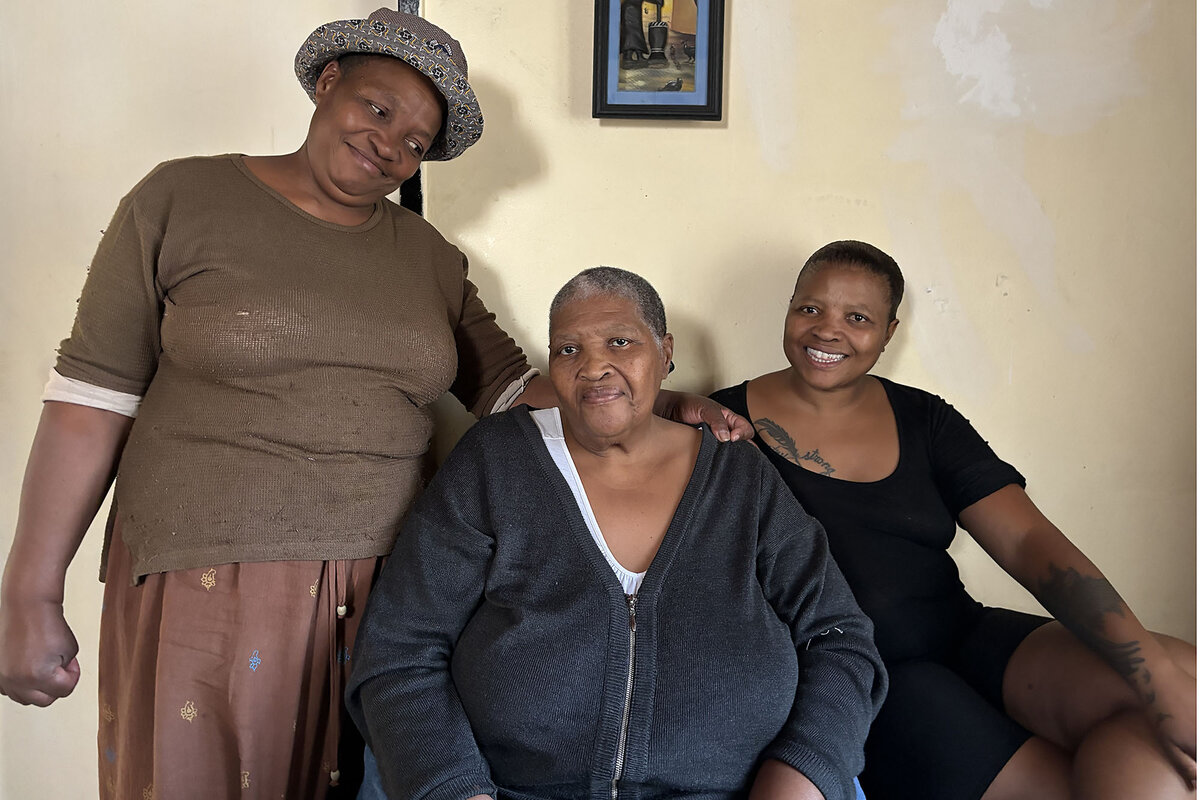
- Quick Read
- Deep Read ( 6 Min. )
On a crisp autumn morning in April 1994, Margaret and Veronica Genge stepped out of their stout brick house in the Soweto neighborhood of Dube, and walked into the future.
Mother and daughter left home as second-class citizens of a country that had been ruled by white people for three centuries. They returned a few hours later as voters in the election that would sweep that old world away.
Like most of the 20 million South Africans who cast their ballots, the Genges voted for the African National Congress (ANC), the organization that had led the anti-apartheid movement.
Thirty years later, South Africans are voting again this week, in an election that could mark another turning point. For the first time ever, the ANC’s share of the national vote may dip below 50%, forcing the ruling party to share power with the opposition.
The excitement that fizzed around the 1994 vote is long gone. In its place is a sense of betrayal, shared by millions.
“All my life I was an ANC supporter because I thought they were going to do better for all of us,” says Margaret Genge, who is now 70 years old. But “I’ve given up on the ANC,” she adds. “They expect us to keep supporting them forever, and then they give us nothing in return.”
South Africans head to polls. After 30 years, has Mandela’s party lost its luster?
On a crisp autumn morning in April 1994, Margaret and Veronica Genge stepped out of their stout brick house in the Soweto neighborhood of Dube, and walked into the future.
History rarely snaps neatly in half, with a clear “before” and “after,” but in South Africa, at that particular moment, it did.
Mother and daughter left home still second-class citizens of a country that had been ruled by white people for three centuries. They returned a few hours later as voters in the election that, within a week, would sweep that old world away.
Like most of the 20 million South Africans who cast their ballots during those electrifying days, the Genges voted for the African National Congress (ANC), the organization that had led the anti-apartheid movement.
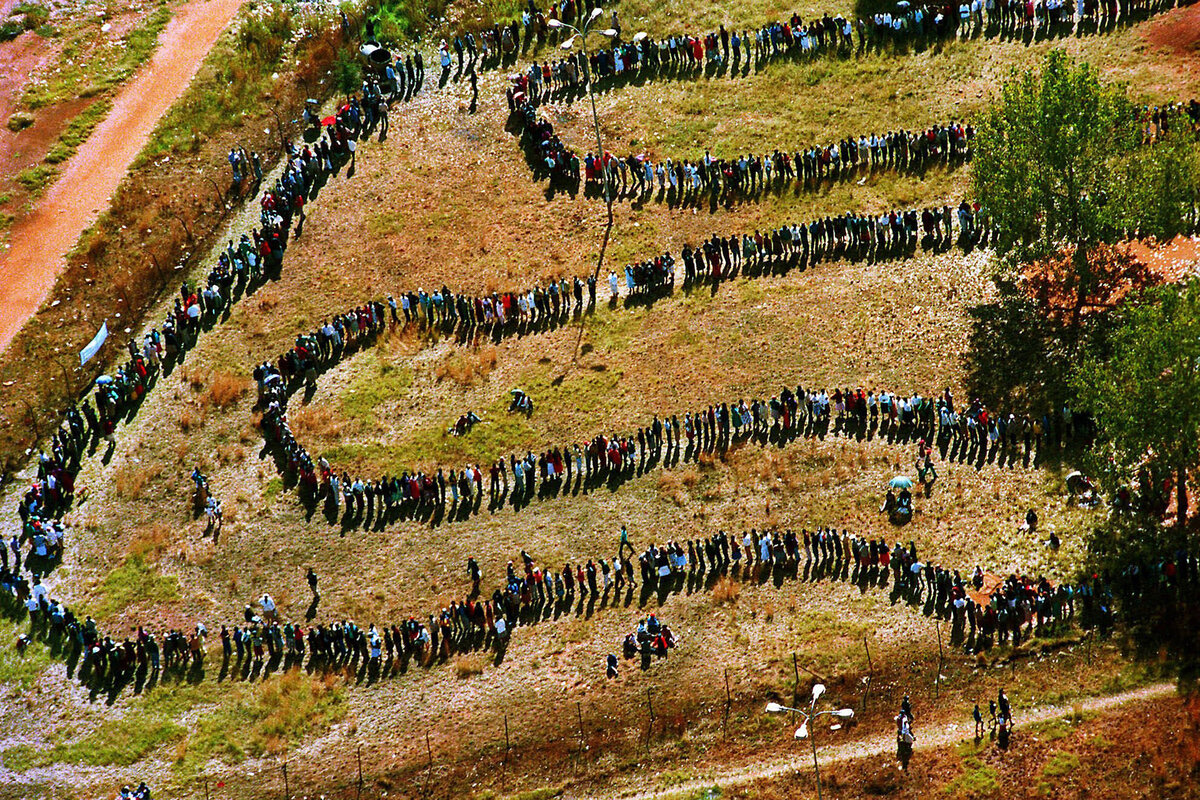
Thirty years later, South Africans are voting again this week, in an election that marks another turning point in the young country’s history. For the first time ever, the ANC’s share of the national vote may dip below 50%, forcing the ruling party to share power with the opposition.
This time around, three generations of Genges will cast their ballots – Margaret, her four children, and her 19-year-old granddaughter. But the excitement that fizzed around the 1994 vote is long gone.
In its place is a sense of betrayal, shared by millions.
“All my life I was an ANC supporter because I thought they were going to do better for all of us,” says Margaret, who is now 70 years old. So why, the Genges’ soft-spoken matriarch wondered, were so many people around her still so poor? When, exactly, were things going to get better?
As the anger bloomed in her chest, she had begun to consider something that was once unthinkable.
“This year,” she told her children, “I don’t think I will vote at all.”
A childhood amid violence
For 66 years, the Genge family has lived in the same three-bedroom house in Soweto, the grid of working-class Black suburbs built by the apartheid government on Johannesburg’s southern edge.
Margaret was a young girl asleep in her bed here during the nights in the early 1960s when police regularly stormed Nelson Mandela’s red brick house a mile and a half away, searching for the ANC leader, then underground and on the run.
Veronica grew up in the family’s Soweto house, too. In one of her first memories, from 1976, she is 4 years old, sitting on the living room floor and listening to the crackle of gunfire. It is the sound of security forces nearby shooting live bullets into a crowd of protesters, most of them children in their school uniforms.
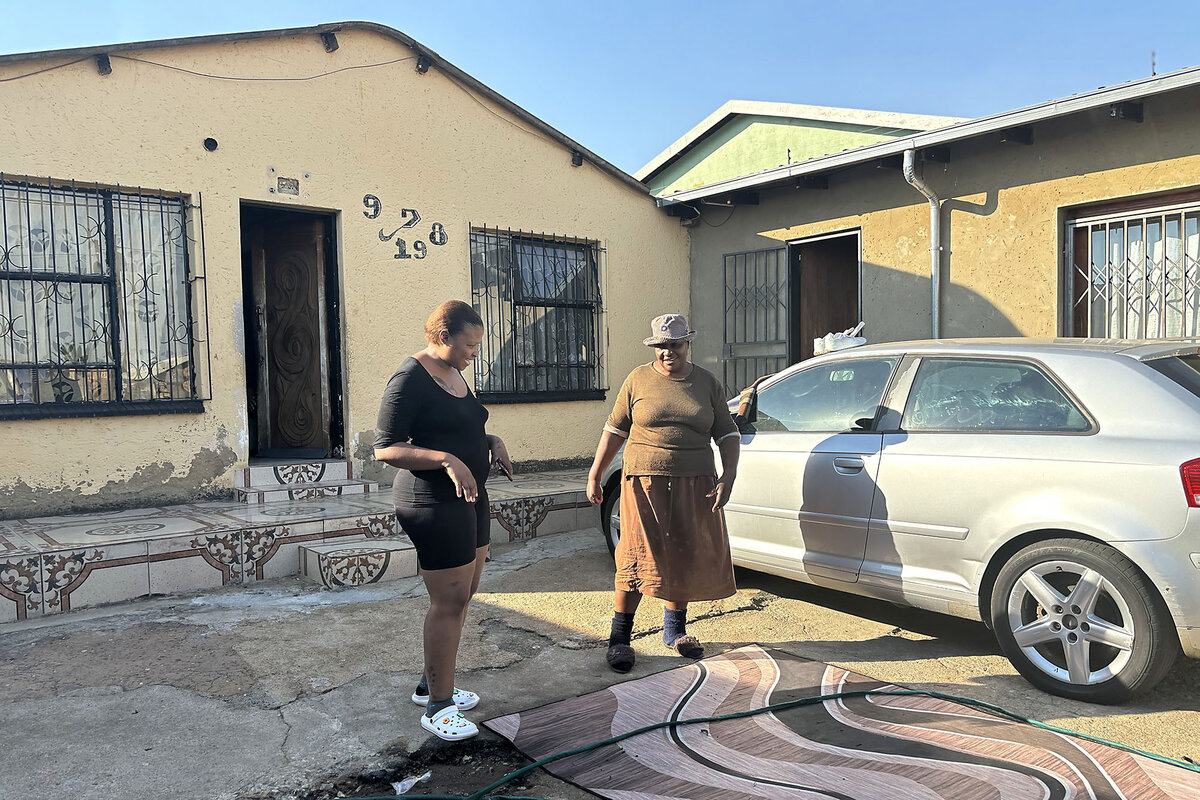
After that, Veronica says, the house’s doors were always locked. Adults told her that if she saw the police, she should turn and run.
In the 1980s, Margaret moved to Yeoville, a vibrant neighborhood near downtown Johannesburg, packed with alternative bookstores, smoky dance bars, and street cafés with striped awnings and elegant foreign names such as Café Pigalle. Black people weren’t technically allowed to live there, but apartheid’s grip was already weakening. The nearby Holiday Inn, where Margaret washed dishes, welcomed Black customers too, and on the weekends, when her kids visited her from Soweto, they splashed around with white children in the Yeoville swembad.
At home in Soweto, things were also changing. In 1987, after three decades of using greasy paraffin lamps for light, the Genges finally saw their house connected to the power grid. The family bought a tiny TV and watched news programs speculating that Mr. Mandela might soon walk free.
When he did emerge from jail in February 1990, after 27 years in prison, the Genges danced in the street. “It was like God himself had come to save us,” says Veronica’s younger sister Nkosazana, who was 11 at the time. “You can’t imagine our happiness.”
Scandals erode faith in the ANC
But sometime in the years since, the family’s optimism began to unravel.
Maybe it happened during the COVID-19 lockdowns, when no one could work and soldiers frog-marched curfew-breakers through the township streets like criminals.
Or maybe it was the electricity problems. For the last two years, the power in Johannesburg has often been switched off for several hours each day, as an overloaded national power grid buckles.
As in the old days, the Genges fired up their paraffin lamps for light.
Maybe, though, the disenchantment came from something bigger than any of that – a nagging sense that South Africa was going backward. In some ways, of course, they knew that things were better than before 1994. Soweto had paved roads, piped water, whole new neighborhoods of identical little houses that the ANC government handed out for free.
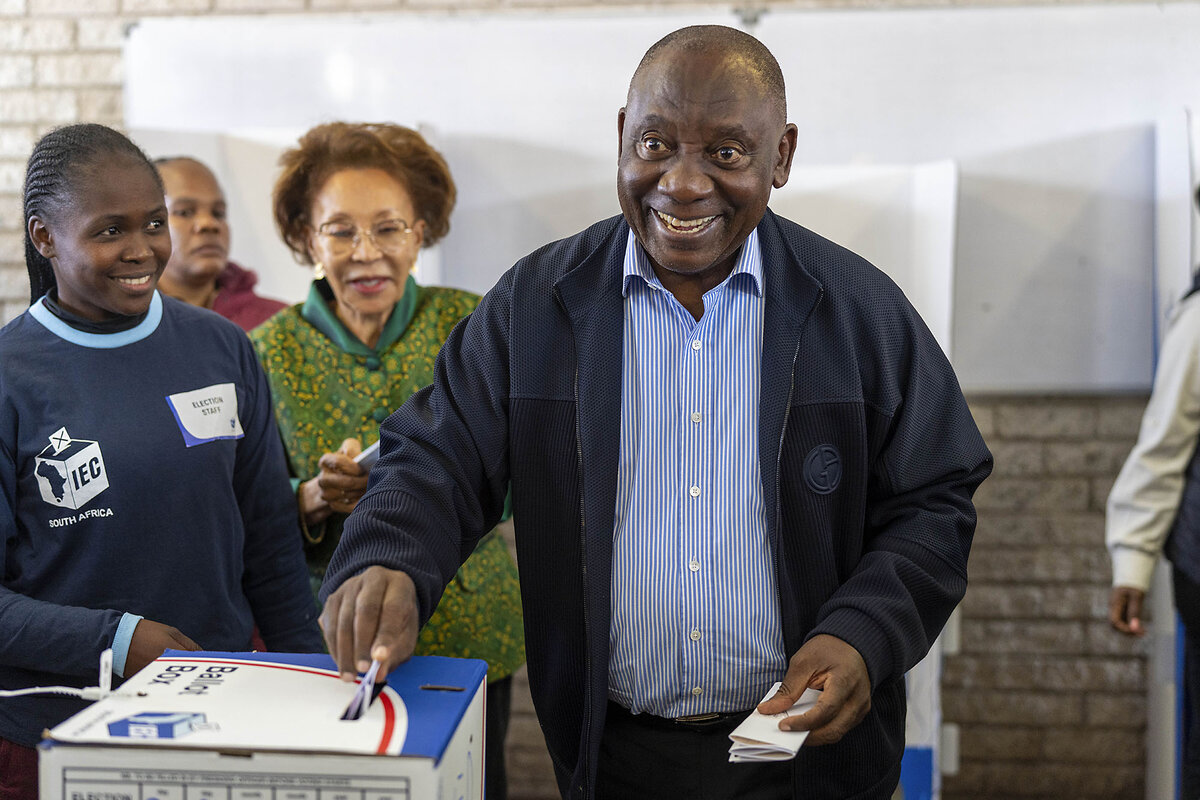
At the same time, most Black South Africans were still poor. The country has one of the highest recorded unemployment rates in the world – more than 30%. ANC leaders have seemed to be constantly embroiled in scandal, such as the discovery that President Cyril Ramaphosa kept half a million dollars in cash stuffed in the cushions of his couch.
For Veronica, the contrast was painful: all that money sloshing around, while people like her lost sleep every time the price of bread went up by another rand ($0.05).
As the May 29 election date approached, Veronica and Nkosazana weighed up their choices lethargically. They were tired of the ANC, but then what? On the telephone poles around Soweto, the opposition parties’ campaign posters seemed to meld together into one generic chorus of despair.
Rescue South Africa. Stop the suffering. We need new leaders.
Uninspiring election options
But while the ANC’s support has been steadily declining since the 1990s, none of its challengers has commanded enough support, until now, to unseat it. The closest anyone has come is the white-led Democratic Alliance, which grew out of an opposition party from the apartheid era. But the DA has failed to build support among the Black working class.
“I heard they still have hatred in their hearts,” Margaret says.
Meanwhile, the other major opposition party in this election is a fiery leftist movement called the Economic Freedom Fighters, which splintered from the ANC in 2013. Recent polls show the DA hovering around 20% of the vote, and the EFF around 10%.
But Veronica, Nkosazana, and her 19-year-old daughter Angela have settled on another upstart party, uMkhonto weSizwe, or MK – which was also the name of the ANC’s armed wing during the liberation struggle. It is led by former president and ANC stalwart Jacob Zuma, a grandfatherly populist who has a complex reputation, as the Genges are the first to admit.
“We know he steals,” Veronica says, referring to the corruption scandals that clouded Mr. Zuma’s tenure from 2009 to 2018. “But he also shares.”
Last week, a court ruled that Mr. Zuma was ineligible to run for office because of his criminal convictions. But the younger Genges decided to stick with his party anyway.
They coaxed their mother to cast a ballot, too.
“Ma, you have to,” Nkosazana told her.
“I guess so,” Margaret said, sighing heavily. It was just that all the choices felt so uninspiring. One thing, though, she knew for sure.
“I’ve given up on the ANC,” she said. “They expect us to keep supporting them forever, and then they give us nothing in return.”

The Trump trial heads to the jury – and a historic decision
As the hush money case heads to the jury, it may be the least important criminal indictment against Donald Trump but likely the only one to come to trial before November.

- Quick Read
- Deep Read ( 4 Min. )
The first criminal trial of a former U.S. president has landed today in the hands of 12 New Yorkers.
The defense and prosecution laid out their closing arguments to the jury Tuesday in former President Donald Trump’s hush money case. The marathon arguments underscored the complexity of the case as well as its historic nature – and the stakes in an election year with Mr. Trump seeking to regain the presidency.
“They wanted to leave nothing left to chance,” says Catherine Ross, a law professor at George Washington University. “They know that whatever happens, what they did in this trial is going to be closely scrutinized by both sides.”
At the same time, it’s unclear whether this or any of the cases against Mr. Trump would actually change the shape of the race. FiveThirtyEight’s general election polling average shows no real change since the New York case began. Although the case centers on Mr. Trump allegedly directing his former lawyer Michael Cohen to pay porn star Stormy Daniels $130,000 to keep her from publicizing a claimed sexual encounter, the actual charges are about drier matters of bookkeeping and election law, and the path to a felony conviction is far from straightforward.
The Trump trial heads to the jury – and a historic decision

The first criminal trial of a former U.S. president has landed today in the hands of 12 New Yorkers.
The defense and prosecution laid out their closing arguments to the jury Tuesday in former President Donald Trump’s New York hush money case, which has gripped the media’s attention and kept the Republican presidential candidate in a courtroom for the past six weeks. Both sides spent an unusually long time summing up their cases – just under three hours for the defense and more than five hours for the prosecution – causing the jury to stay late, long past the courthouse’s 5 p.m. closing time.
Tuesday’s marathon arguments underscored the complexity of the case as well as its historic nature – and stakes. Regardless of the outcome, the trial will forever be an asterisk on Mr. Trump’s presidency and could influence both the next election and American politics for years to come.
“They wanted to leave nothing left to chance,” says Catherine Ross, a law professor at George Washington University and author of the book “A Right To Lie? Presidents, Other Liars, and the First Amendment.” “They know that whatever happens, what they did in this trial is going to be closely scrutinized by both sides.”
At the same time, it’s unclear whether this or any of the cases against Mr. Trump would actually change the shape of the race. FiveThirtyEight’s general election polling average shows no real change since the New York case began a month ago. Other polls suggest that a majority of voters haven’t been paying attention. Although the case centers on Mr. Trump allegedly directing his former lawyer Michael Cohen to pay porn star Stormy Daniels $130,000 to keep her from publicizing a claimed sexual encounter, the actual charges are about drier matters of bookkeeping and election law, and the path to a felony conviction is far from straightforward.
On Wednesday morning, Judge Juan Merchan gave the jurors instructions before they began deliberation, reminding them that they were making “a very important decision about another member of the community.” Mr. Trump had no duty to testify, he said, and did not need to prove his innocence. It is the prosecution that must prove its case beyond a reasonable doubt.
Mr. Trump, who is required to stay in the courthouse while the jury deliberates, seemed to be preparing for a possible conviction Wednesday. “Mother Teresa could not beat these charges,” he told reporters.
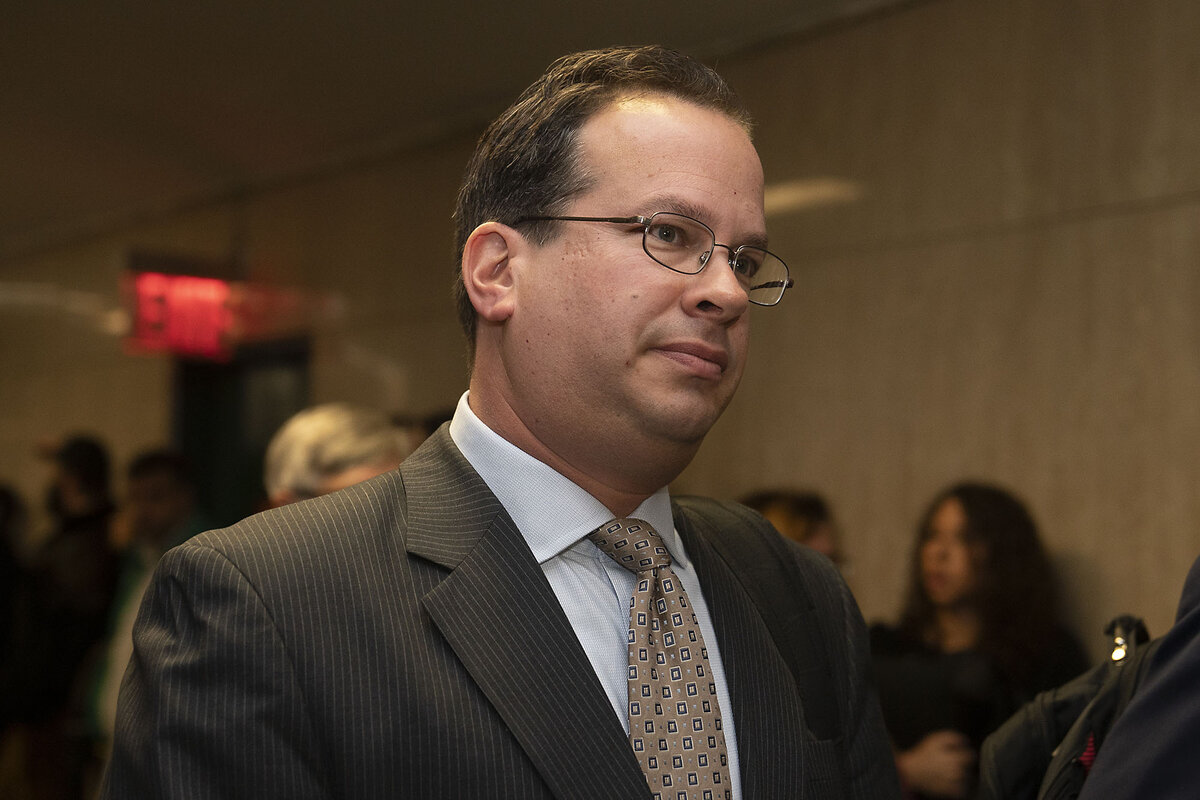
Hush money payments are not illegal. Instead, prosecutors charged Mr. Trump with 34 counts of felony falsification of business records, saying he orchestrated the payoff and deliberately mischaracterized Mr. Cohen’s repayments as “legal expenses” in order to prevent the situation from impacting his 2016 presidential campaign. Mr. Trump has denied the affair with Ms. Daniels as well as the prosecution’s other claims in this case and in the three other criminal cases pending against him.
Mr. Trump, who had professed himself eager to take the stand in his own defense, never did. Legal experts say the defense didn’t need to offer an alternative narrative; it simply needed to poke one or more holes in the prosecution’s case.
“I think of this as a Jenga game,” says Ms. Ross. “The defense needed to destabilize at least one of the building blocks of the prosecution’s case. ... They don’t have the burden to tell a story; they just have to make the structure fall.”
Much of the defense’s closing argument focused on one Jenga block in particular: Mr. Cohen, whom attorney Todd Blanche referred to as “an MVP of liars” and the “GLOAT” – greatest liar of all time. Mr. Cohen was the only witness able to establish that Mr. Trump knew of the hush money payments, but he has also been sentenced for felonies and and has a history of perjury. “He’s the human embodiment of reasonable doubt,” said Mr. Blanche when capping off his list of 10 reasons the jury should not convict his client.
Taking the podium after a lunch break Tuesday, the prosecution moved quickly to defend Mr. Cohen’s testimony. Prosecutor Joshua Steinglass conceded that Mr. Cohen, with his established history of theft and lying, isn’t necessarily whom they would have chosen at “the witness store,” but noted that he was chosen by Mr. Trump for jobs that “no one else wanted.”
“The prosecution often has to rely on witnesses with baggage because those are the ones with the inside scoop, those are the ones in the room where it happened,” says Cheryl Bader, a criminal law professor at Fordham Law School and former assistant U.S. attorney for the District of New Jersey. “The prosecution has to show why, in this instance, Cohen is telling the truth. ... The alternative is that Cohen paid [Ms. Daniels] out of the goodness of his heart, and that’s not a plausible narrative.”
The prosecution also reiterated in its closing arguments that it had provided evidence corroborating Mr. Cohen’s testimony. It showed the jury Sharpie-signed checks from Mr. Trump, invoices, call logs, and handwritten notes from Trump Organization officials about the payments to Mr Cohen.
“The defense said, ‘This is a paper case,’ as if that’s not a case,” says Ms. Ross, with a laugh. “You don’t normally have all these receipts.”
Editor’s note: This story has been updated with the judge’s instructions to the jury, and a comment by the defendant.

The Kremlin is all-in on war in Ukraine. That includes transforming Russia’s economy.
Despite an unprecedented array of Western sanctions, Russia has persevered, even prospered. Now the Kremlin appears to be consolidating its economy fully toward the waging of war in Ukraine.

- Quick Read
- Deep Read ( 5 Min. )
Despite Western sanctions, Russia’s economy is back at a level that outproduces the entire West in some key military goods. And the Kremlin appears to be committed to a war economy for the long haul.
Though Russia’s gross domestic product shrank by 1.2% in 2022, it grew by 3.6% the next year and is expected to expand by as much as 5% this year. Experts say that growth is being driven by military expenditures, which have ballooned from about $75 billion before the war to almost $400 billion this year.
To manage the tsunami of new money into Russia’s military machine, Mr. Putin recently replaced Sergei Shoigu with economist Andrei Belousov.
Analysts say that Mr. Belousov will attempt to implement a U.S.-style “military Keynesianism,” in which industry is made to focus on war priorities through the incentive of lucrative state contracts. His task will be to streamline procurement, keep costs down, and induce business to react quickly to changing battlefield requirements.
“The Ministry of Defense has lots of money, but it is spent in strange ways,” says Natalya Zubarevich, an economic geographer. “To make all that money work more effectively, to optimize it, is a very big job.”
The Kremlin is all-in on war in Ukraine. That includes transforming Russia’s economy.

Amid its grinding war of attrition and economic mobilization against Ukraine, Russia is changing fast.
As the Defense Ministry spends ever-increasing amounts of money to procure the equipment it needs and to recruit more soldiers, the country’s business environment and economic geography are being reshaped. And the military-industrial complex, which was vastly downsized in post-Soviet years, is reviving quickly.
Confounding observers in many ways, Russia’s war economy, despite Western sanctions, is now back at a level that outproduces the entire West in some key military goods. And the Kremlin appears to be committed to a war economy approach for the long haul, as suggested by the recent reshuffling of Defense Ministry leadership.
Whether such an economic policy is viable is in debate. Optimists say the rapid economic development is economically positive on balance, or at least that Russia can sustain high levels of military spending for the foreseeable future. Pessimists argue that the Kremlin is building a permanent war economy, much like the one that strangled the Soviet Union, and that hopes of building a prosperous consumer economy are fast vanishing. But for the moment, Russian President Vladimir Putin appears all in.
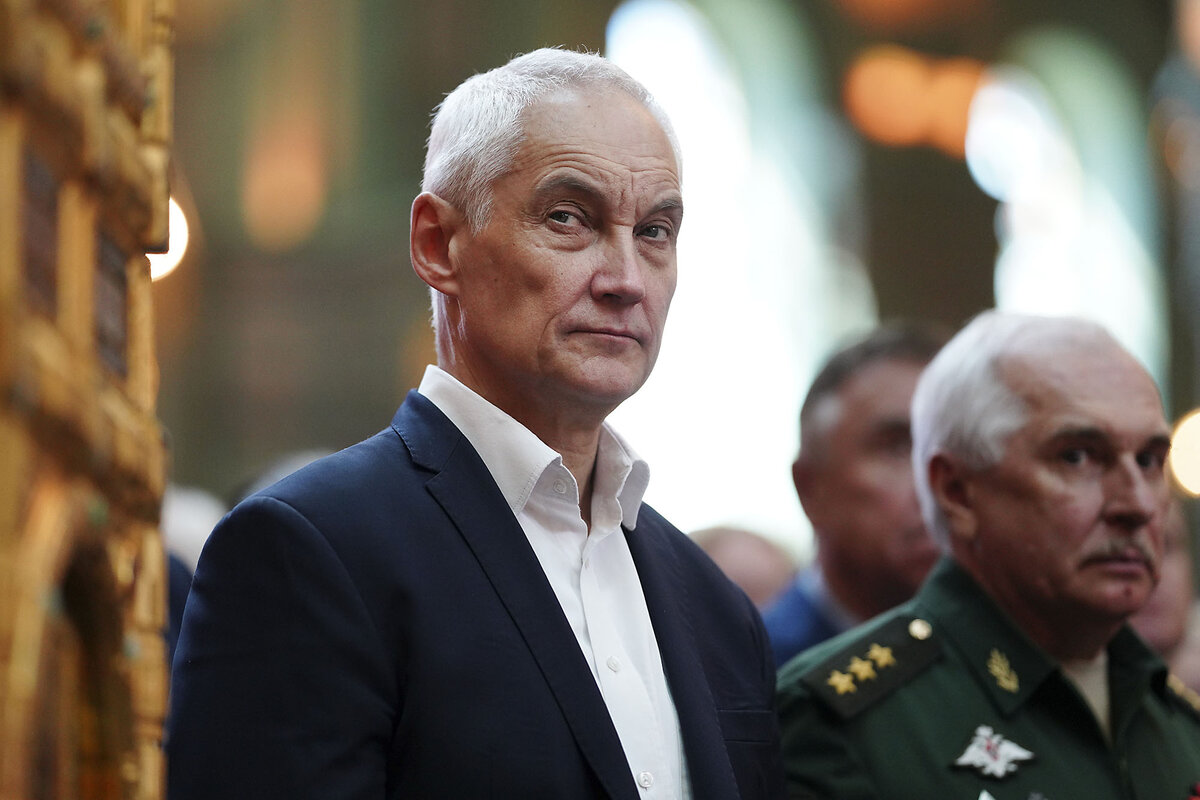
“We have an overheating economy, and it’s changing in some ways. But for now it seems manageable,” says Alexei Vedev, an economist with the Gaidar Institute in Moscow. “If the war ends, as we all hope it will, it will be necessary to reverse some of the structural changes that are happening. We’ll have to seriously tackle inflation. And Russia needs sources of foreign investment,” which have largely dried up with the exodus of Western businesses from Russia.
Russia’s war engine
Many Western observers are belatedly acknowledging that Russia is politically consolidated and unexpectedly resistant to the most intense barrage of sanctions in history. And even while ostracized by the West and its friends, Russia appears to have strengthened its relations with China and many important countries of the Global South.
But most surprising has been the Russian economy’s capacity to field and equip a growing army amid a long, grinding war of attrition, while continuing to provide stable living standards for the population.
Though Russia’s gross domestic product shrank by 1.2% in 2022, it grew by 3.6% the next year and is expected to expand as much as 5% this year. Experts say that much of that growth is being driven by vastly increased military expenditures, which have ballooned from about $75 billion before the war to almost $400 billion this year. Thanks to its ability to continue exporting energy and raw materials, Russia can afford it.
The biggest shock, for many observers, has been the ability of Russia’s economy to rapidly ramp up war production to levels unseen since the Cold War. As recently as five years ago, Russian military spending was actually falling, but Mr. Putin recently said it’s now around 8% of GDP and climbing.

While that has produced inflation of almost 8% and interest rates of up to 20%, it’s also churning out the arms, materiel, and munitions sufficient to keep the Russian armies pressing forward in Ukraine. For example, Russian industry now produces three times more artillery shells than Europe and the United States combined, according to a recent report.
An adaptive economy
To manage the tsunami of new money into Russia’s military machine, Mr. Putin recently replaced his longtime loyal defense minister, Sergei Shoigu, with an economist, Andrei Belousov. Mr. Belousov is reputedly highly competent in matters of finance, but has no known military background.
Analysts say that Mr. Belousov will attempt to implement a policy resembling U.S.-style “military Keynesianism,” in which industry is made to focus on war priorities – not through Soviet-style central planning and command, but with the incentive of lucrative state contracts. His difficult task will be to streamline the process of procurement, keep costs down, and induce business to innovate and react quickly to changing battlefield requirements.
“Belousov supports the idea that the state has to invest into technological development and participate in the modernization of industry,” says Natalya Zubarevich, an economic geographer at Moscow State University. “The Ministry of Defense has lots of money, but it is spent in strange ways. To make all that money work more effectively, to optimize it, is a very big job.”
According to Ms. Zubarevich, some industrial and mining regions that support war production are thriving, while others that rely on exports like coal and gas are hurting while they struggle with disruptions from sanctions. On the whole, because of industrial growth and an acute labor shortage, wages are rising rapidly.
“The population’s incomes were up 16.5% as of January this year,” she says. “Effective demand is up, and new business opportunities are opening up. A lot of wealthy Russians are locked out of the West and have no way to get their money out. So they are investing in Russia. On the whole, for now, the Russian economy seems to be adapting.”

The former Soviet Union spent up to 20% of GDP on the military over a long period. Russian analysts say the country might be able to spend 10% for a few years without becoming bogged down.
“Russia is a market economy, and it’s much more flexible and adaptable than the Soviet one,” says Ms. Zubarevich.
Societal changes to come?
Russia’s ability to recruit up to 30,000 soldiers monthly using economic inducements has enabled it to avoid another forced mobilization like 2022’s emergency drive, which led to serious public disruptions.
It also portends lasting social changes. Russia has a preexisting culture of honoring war veterans, and a new generation of men who served in Ukraine is already being glorified. When the war ends and all these men return to civilian life, they will be expecting a reward.
“At the beginning, participants of the special military operation were being paid about 200,000 rubles [about $2,200], but now payments have grown up to as much as 1 million [about $11,000],” says Ms. Zubarevich. “They and their families are the beneficiaries of this situation,” which has stimulated a housing boom in some regions. “What happens when they return home, what will their future status be? I do not know.”
Andrei Movchan, a Russian financier and former director of the Moscow Carnegie Center who now lives in Britain, says the war has been beneficial for Mr. Putin’s regime, enabling it to consolidate power, eliminate opposition, isolate Russia from the West, and create short-term economic stimulus. But, he says, the long-term price tag will keep growing.
“This situation reminds us of the processes in the Soviet economy in the late ’60s onward, when an increasing share of resources was spent on military purposes, which were given priority over consumer production,” he says. “We are seeing Russia take that road once again.”

In Pictures
To build trust with pet owners, outreach team hits the road
Helping owners care for their pets often requires trust and visibility in the community. This nonprofit is lending a paw to meet the challenge.

- Quick Read
- Deep Read ( 2 Min. )
-
Stephen Humphries Staff writer
Missy the tomcat was roaming his Boston neighborhood with a wound on his chest. Alyssa Krieger went door to door until she found his home. The cat’s owners had been worried about Missy but didn’t have the money – or a car – to take their pet to a veterinarian.
“I basically said, ‘Hey, why don’t I take him to do that for you? And then I will bring him back,’” Ms. Krieger recalls. “They did not know me at all, but they were like, ‘OK, I trust you.’”
It was all in a day’s work for Ms. Krieger, who heads a Boston-based team of seven outreach workers for the Massachusetts Society for the Prevention of Cruelty to Animals (MSPCA). The team has a proactive response to the number of pets from disadvantaged areas ending up in shelters. Many owners have had bad experiences with the MSPCA. Its former adoption policies, such as requiring references or asking to see pictures of a prospective owner’s yard, upheld a system of class and racism, Ms. Krieger says.
“Trust goes both ways,” she explains. “We trust them to care for their pets.”
Expand this story to see the full photo essay.
To build trust with pet owners, outreach team hits the road
To save Missy the cat, Alyssa Krieger had to gain the confidence of his owners. The tomcat had been spotted wandering with a wound on his chest. So Ms. Krieger went door to door in Missy’s Boston neighborhood until she found his home. The cat’s owners each worked 80 hours a week. They had been worried about Missy but didn’t have the money – or a car – to take their pet to a veterinarian.
“I basically said, ‘Hey, why don’t I take him to do that for you? And then I will bring him back,’” Ms. Krieger recalls. “They did not know me at all, but they were like, ‘OK, I trust you.’”
Ms. Krieger heads a Boston-based team of seven outreach workers for the Massachusetts Society for the Prevention of Cruelty to Animals (MSPCA). The team has a proactive response to the number of pets from disadvantaged areas ending up in shelters. Many owners have had bad experiences with the MSPCA. Its former adoption policies, such as requiring references or asking to see pictures of a prospective owner’s yard, upheld a system of class and racism, Ms. Krieger says. The MSPCA’s Boston community outreach team takes a nonjudgmental approach to building partnerships.
“Trust goes both ways,” says Ms. Krieger. “We trust them to care for their pets.”
The team is careful not to admonish owners if they forgo spaying or neutering their pets. But it will happily support and facilitate those procedures, if asked. The MSPCA’s clinic also does microchipping, rabies vaccinations, and nail trims. And the outreach team’s pop-up pantries – blue vans stocked with pet food – have distributed more than 10 million meals since 2020.
That visibility in the community is key. Ms. Krieger’s team members aren’t outsiders coming into the neighborhood. “Folks will flag down our van, or honk at us, or wave,” she says. “Everybody knows us.”
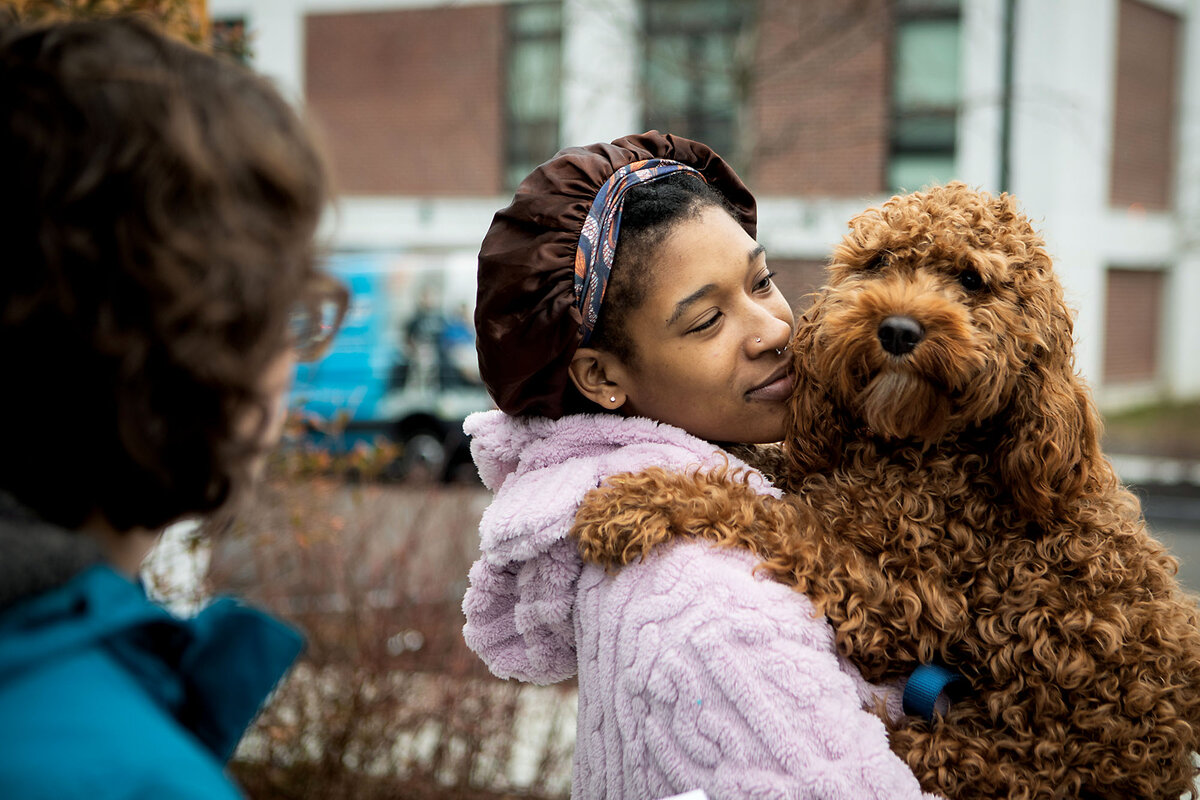


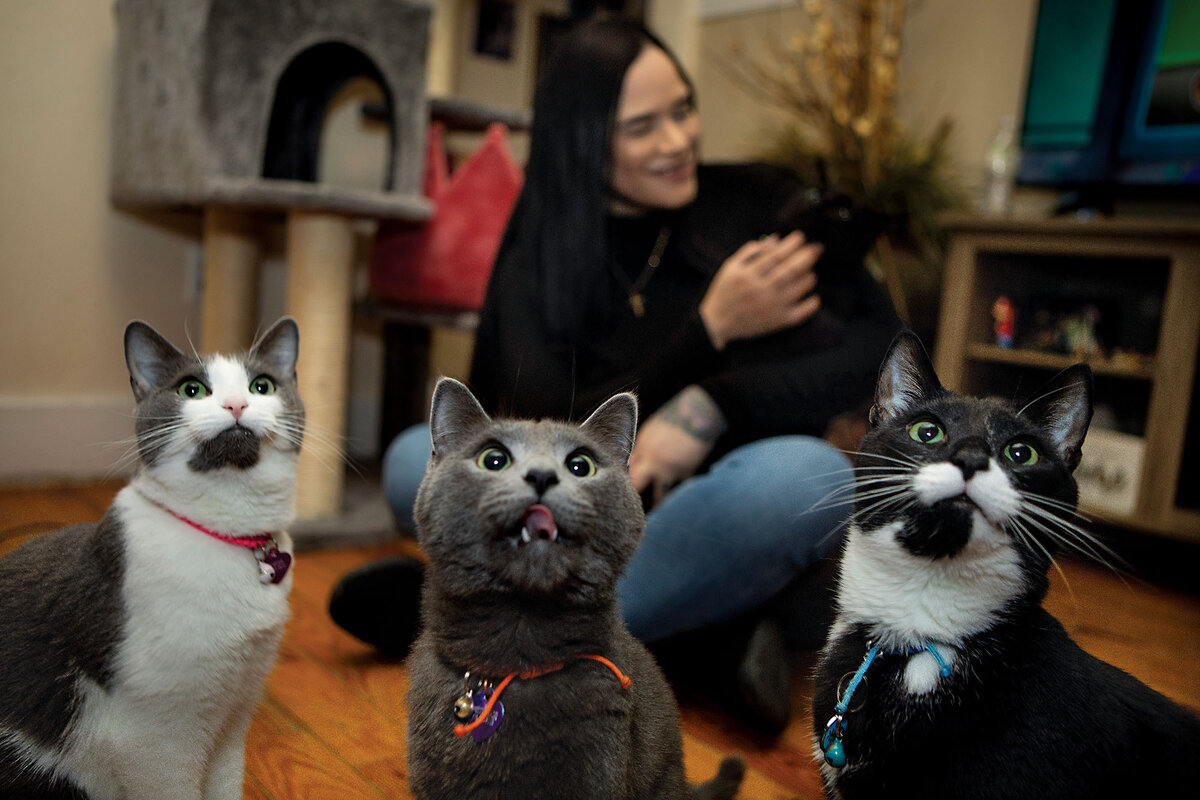

Other headline stories we’re watching
(Get live updates throughout the day.)The Monitor's View
Baseball steps up to a unifying plate
- Quick Read
- Deep Read ( 3 Min. )
-
By the Monitor's Editorial Board
A great milestone in professional baseball was that day in April 1947 when Jackie Robinson strode onto Ebbets Field in Brooklyn as the first Black player in the major leagues. That began the end of the Negro Leagues, which had consisted of mainly Black players because of forced segregation. Now, baseball has a new milestone.
Pro ball has revised its record books, aggregating statistics on player performance from both leagues going back decades. In this new telling, for example, Black player Josh Gibson replaces Ty Cobb, Hugh Duffy, and Barry Bonds as the game’s greatest hitter. The new records result from painstaking historical and statistical work to fairly compare the performances of players in leagues without comparable seasons.
But baseball statistics aren’t just about what happened on the field. They capture a history of integration. Like curtains peeled back, batting averages and stolen bases are narratives of lived experience, lenses on how different communities experience America and what ultimately binds them.
Baseball steps up to a unifying plate
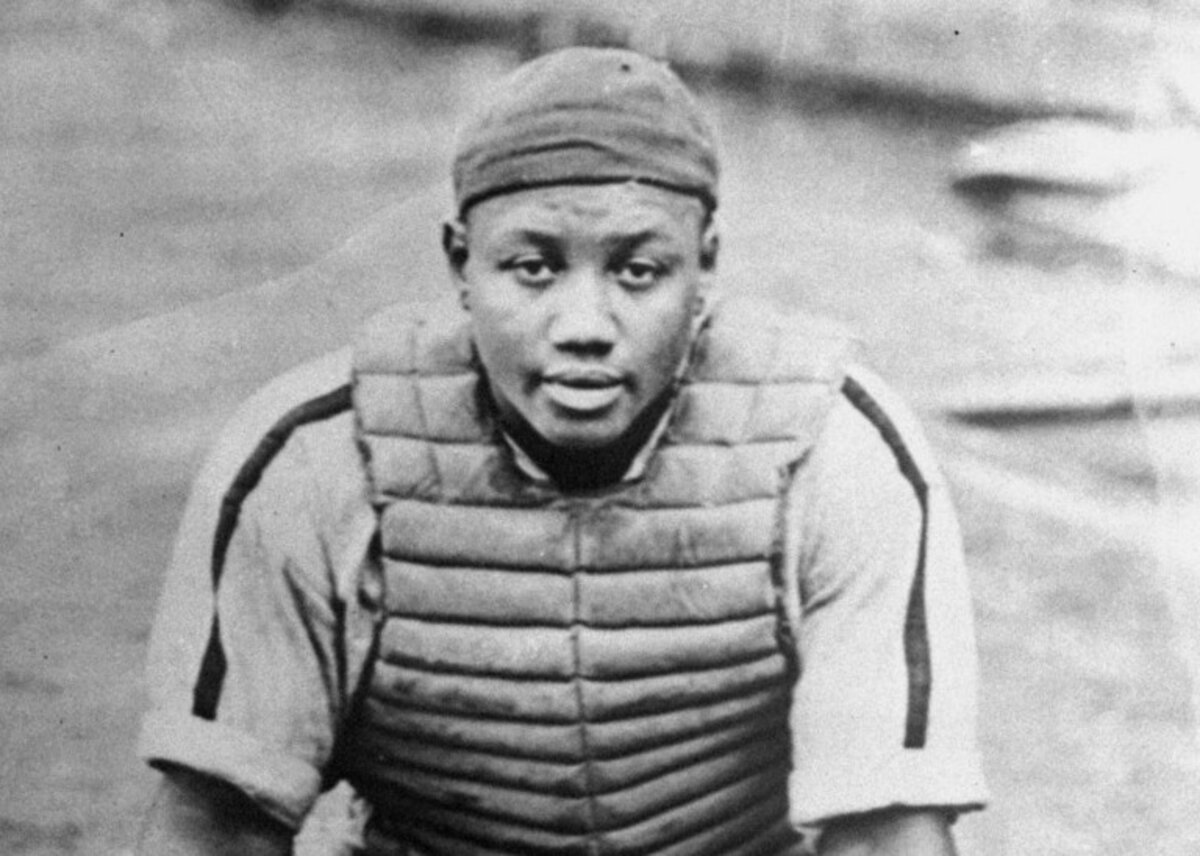
A great milestone in professional baseball was that day in April 1947 when Jackie Robinson strode onto Ebbets Field in Brooklyn as the first Black player in the major leagues. That began the end of the Negro Leagues, which had consisted of mainly Black players because of forced segregation. Now, baseball has a new milestone.
Pro ball has revised its record books, aggregating statistics on player performance from both leagues going back decades. In this new telling, for example, Black player Josh Gibson replaces Ty Cobb, Hugh Duffy, and Barry Bonds as the game’s greatest hitter. The new records result from painstaking historical and statistical work to fairly compare the performances of players in leagues without comparable seasons.
But baseball statistics aren’t just about what happened on the field. They capture a history of integration – from the first Jewish and Italian ballplayers to today’s Asian phenoms. Like curtains peeled back, batting averages and stolen bases are narratives of lived experience, lenses on how different communities experience America and what ultimately binds them.
What emerges is a deeper story of persistent dignity and the pursuit of equality expressed through excellence. Hank Aaron once criticized Willie Mays for not speaking out more against racism. Yet the “Say Hey Kid” made his case for inclusivity through hustle and home runs.
“People ... may be uncomfortable with some Negro League stars now on the leaderboards for career and seasons,” Larry Lester, a baseball historian who served on the committee that combined the record books, told The New York Times. What matters, he says, is the conversations they spark.
Baseball’s more inclusive narrative is part of a broader reckoning with how Black people have mitigated racial inequality. In her 2021 study of unpublished Black literature from the early 20th century, for example, New York University English Professor Elizabeth McHenry chronicles a history of resistance and resilience in the face of segregation and rejection. The 2016 film “Hidden Figures” portrayed the role of NASA’s Black female mathematicians in the space program.
One effect of these reshaped narratives is more empathy and humility. Following the death of George Floyd in 2020, NFL Commissioner Roger Goodell said he wished “we had listened earlier” to professional football players kneeling during the national anthem to protest police violence.
A Stockholm University study on art and immigration noted last year how diverse societies are bound together by common points of reference. Harmony, or the “favourable conditions [of] a just, equal and inclusive society,” its author wrote, rests on a “collective consciousness” of shared values and rules.
Up until 1948, the ballplayers in the Negro Leagues confronted discrimination yet also dazzled fans and seeded Black journalism and entrepreneurship. But they were constantly told they were not good enough to face white ballplayers until Mr. Robinson broke the color barrier.
Now, the newly desegregated statistics of baseball’s segregated history “tell the story of the game, and the nation, inclusively,” as John Thorn, MLB’s official historian, told Rolling Stone. It is also a story of recognizing the innate talent of each individual, regardless of skin color.

A Christian Science Perspective
Each weekday, the Monitor includes one clearly labeled religious article offering spiritual insight on contemporary issues, including the news. The publication – in its various forms – is produced for anyone who cares about the progress of the human endeavor around the world and seeks news reported with compassion, intelligence, and an essentially constructive lens. For many, that caring has religious roots. For many, it does not. The Monitor has always embraced both audiences. The Monitor is owned by a church – The First Church of Christ, Scientist, in Boston – whose founder was concerned with both the state of the world and the quality of available news.
Freedom from the tangle of resentment
- Quick Read
- Read or Listen ( 4 Min. )
-
By Larissa Snorek
Venturing to see life from the perspective of divine Love opens us to truly forgiving those who have hurt us.
Freedom from the tangle of resentment
Corrie ten Boom and her family were heroes of the Dutch resistance during World War II. They hid many Jews and helped them escape to safety. Eventually Corrie and five members of her family were arrested; later, Corrie and her sister Betsie were sent to a death camp, where Betsie died. After the war Corrie spent the rest of her life speaking about God’s forgiveness, the need for reconciliation, and her experiences with love overcoming evil.
At the ten Boom house in Haarlem, Netherlands, there’s an exquisitely framed embroidery of a crown. During talks, Corrie would hold it up, first showing the backside of the embroidery where hundreds of tangled colored threads hung in a mess. Then she would flip it around to reveal the beautifully stitched crown. She said we often view our lives from the tangled side, whereas God views our lives as the perfectly woven crown. This perspective enabled Corrie ultimately to forgive the man who’d betrayed her family to the Nazis.
Most of us will not have experiences as terrible as Corrie’s that are calling for our forgiveness. But regardless of the circumstances, forgiving when we’ve been wronged doesn’t always come easily. It may be the most demanding counsel of Christ Jesus’ teachings. He modeled the importance of it when he said on the cross, “Father, forgive them; for they know not what they do” (Luke 23:34).
This spirit of Christly love that Jesus demonstrated has the power to open our hearts to God’s love and transform us from feeling hatred or resentment to actively affirming good for others – even those who’ve wronged us. Praying that our enemies can feel the healing love of God, we are embraced by this love ourselves. As the power of the Christ-spirit uproots resentment in our hearts, we are no longer imprisoned by that resentment. We are free to love the true, God-given goodness of ourselves and others.
This Christ – the divine influence – inspires and frees us, revealing our core being. We discover the Christ as our true, Godlike nature, showing us our wholeness and completeness as God’s child and shifting thought away from victimization to healing and transformation. Through Christ we gain an understanding of our spiritual completeness. We begin to identify with qualities of God more than with human events, and we see that we were never broken by another’s wrong action.
I spent almost seven years not talking to a close family member because I couldn’t forgive his abusive behavior. I felt that if I forgave, I was somehow condoning the wrongful treatment. But the Christ-influence moved me little by little into feeling the infinite love and universal intelligence of God, and this finally replaced the resentment. I could see how the lack of forgiveness was only hurting me.
The foundation for these realizations was the teachings of Christian Science. These teachings explain how we can each turn from focusing on what may feel like a messy human life to seeing things from the standpoint of divine perfection – God’s perfection reflected in each of us, God’s loved spiritual ideas. The power to do this is not one of will or self-help, but is the Christ-power breaking through resistance and enabling us to yield to the spiritual understanding of Life and Love, which are synonyms for God. As we see our life spiritually, we see the perfectly woven crown of divine Love rather than a tangled mess of mistaken beliefs.
I eventually forgave the family member mentioned earlier, although it took a few more years before we reconciled and began communicating again. By then, he had undergone a complete transformation, and all the previous behavior had stopped. We now have a close and caring relationship.
More than just a choice we might make, forgiveness is a divinely impelled willingness to yield human thought to God’s love working in us. This happens when we separate the wrongful act from the pure idea of God, the spiritually created identity of the individual.
If the wrong done us feels much bigger than the spiritual truth we want to embrace, we can hold to a desire to know love rather than resentment, truth rather than a tendency to react negatively. As we feel divine completeness and wholeness in ourselves rather than holding on to thoughts of retribution, this will chip away at the desire for revenge and finally crush it with healing love and forgiveness.
As God’s love grows in our consciousness and we feel its presence, any sense of ever having been harmed will be removed. The tangled mess of threads will be replaced by a whole, beautiful crown of God’s blessing.
Adapted from an editorial published in the March 23, 2020, issue of the Christian Science Sentinel.

Viewfinder
‘S-t-r-e-t-c-h. Stretch!’
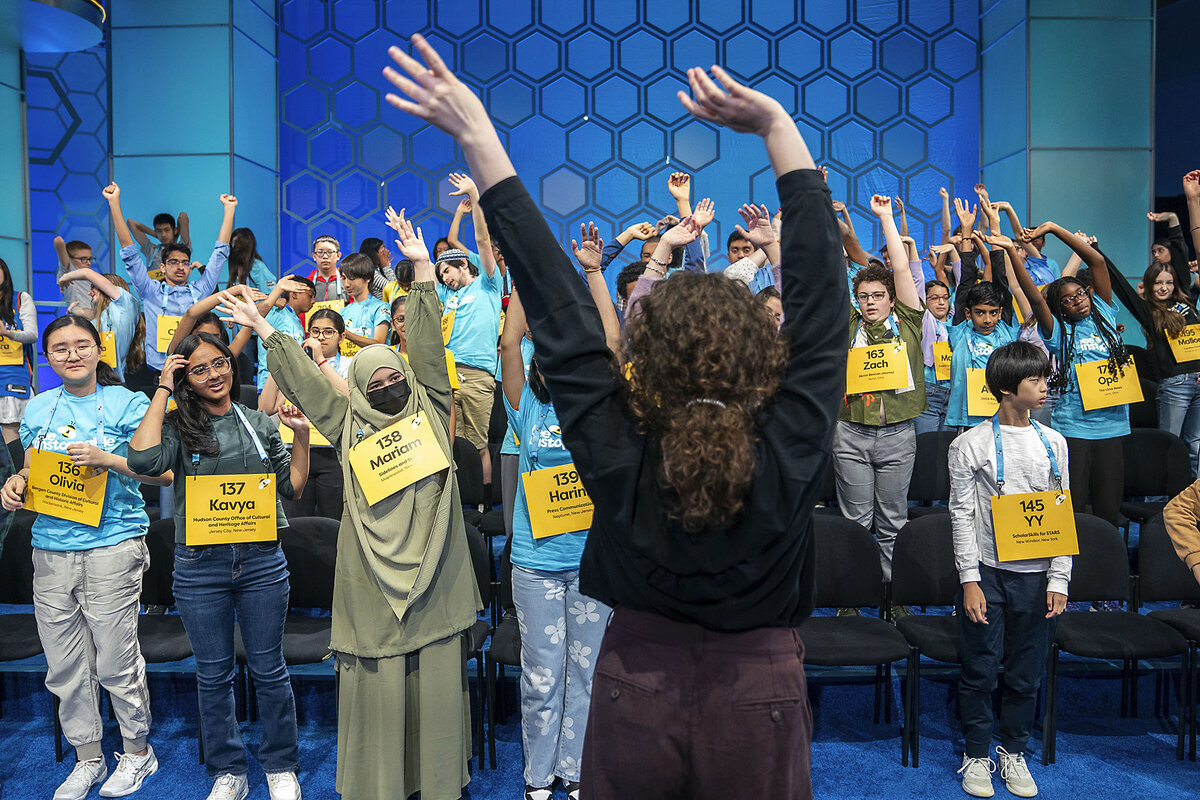
A look ahead
Thanks for joining us today. Tomorrow, we’ll look at what’s behind Ukraine’s largely unheralded success in opening up a secure Black Sea shipping corridor that has returned the country’s grain exports to near-prewar levels.



